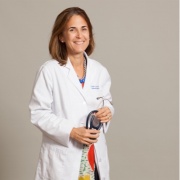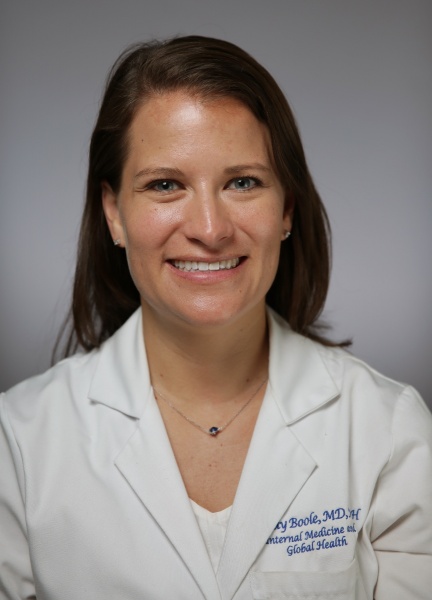From the Director

Whew! What a busy week. And Duke on to the Sweet 16. Who cares if my bracket is busted!
Thanks to everyone for their hard work and support during our ACGME visit. Stop by my office anytime if you want to talk about it (or anything else for that matter!) I will have my door open as much as possible, but generally on Tuesday mornings from 9-11 and also Thursday afternoons from 4-5:30, so please stop in. Also, don’t be surprised if you see me or the APD’s and Chiefs hanging around the wards and checking in. TBH (I learned this from Jake’s Instagram), we had set a goal to be ‘out and about’ on the wards and in the clinics more this year, and will be making much more of an effort to do so.
And a huge welcome to our AMAZING new intern class! Categorical medicine, prelim medicine, med psych and med peds all are celebrating an absolutely outstanding match. Notably, our categorical class represents 35 different medical schools, is 53% women, 18% under-represented minorities, has 7% physician-scientists, and even 9% have expressed career interest in infectious diseases (a little bit of a gratuitous shout-out to my specialty). We are really excited to welcome such fantastic individuals to our Duke family. As always, no one is more excited than the current intern class to have someone ‘page the intern’ that is not them.
Kudos this week go to Josh Lee from Nathan Gray for his outstanding work over the weekend on 9300, to Jared Lowe for good spirits during real and mistaken pulls, to Ashley Bock, Ryan Orgel, David Sermer, Laura Miller and Michael Dorry from Brian Griffith for excellent Night Float work at Duke, and to Armando Bedoya and Meredith Clement for earning a DIHI grant to support their work on adapting the NEWS score system to Duke, with mentor Cara O’Brien.
Fellowship and job meetings with the JARs have begun - please email Madi to set up a time if you haven’t already. SARs, also please remember to get your procedure logs done. We can help you arrange for opportunities but this is best not left until June.
This week’s pubmed from the program goes to Tim Hinohara for his abstract at the ACC … Hinohara TT, Fordyce CB, Sherwood MW, Gu J, HR Al-Khalidi, Roettig ML, Tammis-Holland JE, Burchenal JE, Wilson BH, Berger PB, Monk C, Cobbet C, Jollis JG, Granger CB. Impact of Regional Systems of Care on Disparities of Care in Women and Blacks Presenting With ST Segment Elevation Myocardial Infarction. Poster at American College of Cardiology (ACC): 2016 Scientific Sessions Chicago, IL April 2016.
Have a great week!
Aimee
What Did I Read This Week?

Submitted by Lindsay Boole, MD
Well, maternity leave does allow for some bleary-eyed reading, so I couldn’t wait to submit a WDIRTW now that I’m back! First, I have to give co-author credit to my partner in crime, Romel (pronunciation guide: Ro as in rotator cuff, mel as in MELD score). This little kiddo was a pretty fun reading companion.

Just a wild guess that only a select few of you would want to read a WDIRTW on Babywise: Giving Your Infant The Gift Of Nighttime Sleep, so Armando and I decided to do a two-part series on the new sepsis definitions that were published in JAMA about three weeks ago. See the March 7 Residency News for Armando’s summary of the new sepsis definition. In this WDIRTW, I’ll tell you about the new definition of septic shock.
Shankar-Hari, et al. Developing a New Definition and Assessing New Clinical Criteria for Septic Shock For the Third International Consensus Definitions for Sepsis and Septic Shock (Sepsis-3). JAMA. 2016;315(8):775-787.
Like the new sepsis definition, the septic shock definition was developed via a structured, semi-quantitative process. The authors took the following three steps.
1. A systematic review
They identified 44 adult, English language studies, observational studies of septic shock and outcomes published since 1992 (when the sepsis definitions as we used to know them were published). They excluded studies in which specific pathogens were responsible for the sepsis or in which only specific patient populations were studied.
There were a wide range of criteria used in those studies to define septic shock, including a number of SBP and MAP cutoffs, as well as lactate thresholds and base deficit. There were also a variety of criteria used to define “persistent hypotension,” and “resuscitation.” Unsurprisingly, there was a high level of heterogeneity in septic shock mortality reported, with mean mortality of 46.5% but variation from 23.0% to 81.8%.
2. The Delphi method
Taking the above systematic review into account, the task force members went through several structured rounds of debate and votes to reach a consensus definition of septic shock. I’ll spare you the details of the votes, other than the fact that most decisions were not completely unanimous. They agreed on the following new definition of septic shock:
“Septic shock is defined as a subset of sepsis in which underlying circulatory, cellular, and metabolic abnormalities are associated with a greater risk of mortality than sepsis alone.”
They also voted for the following three test variables (below) that they wanted to look at as possible clinical criteria.
3. Three retrospective cohort studies
They tested the three variables agreed upon:
- hypotension after fluid resuscitation
- serum lactate >2 mmol/L
- vasopressor therapy within 24h after infection was first suspected (yes/no) for their predictive ability in three different cohorts.
Cohort #1: The Surviving Sepsis Campaign database
This was the derivation cohort. They tested various combinations of the 3 clinical criteria above and found that patients with all three characteristics had the highest crude and adjusted hospital mortality (42.3% crude, aOR 3.1 with patients with hypotension but normal lactate and no vasopressors as the reference). By majority vote, they agreed that those patients with all 3 characteristics were most consistent with the new septic shock definition (in bold above).
Cohort #2: UPMC EHR cohort
In this validation cohort of 148,907 patients with suspected infection and SOFA score ≥ 1 gleaned from the UPMC EHR, the new criteria were associated with a 54% hospital mortality rate.
Cohort #3: Kaiser Permanente EHR cohort
In this validation cohort of 321,380 patients with same population as cohort #2 above, the new criteria were associated with a 35% hospital mortality rate.
In summary, the new criteria for septic shock are all 3 of: hypotension after fluid resuscitation, use of vasopressors, and lactate ≥2 mmol/L.
Recall that under the old criteria, lactate cutoff was 4 mmol/L and either an elevated lactate or vasopressor-dependent hypotension alone qualified a patient as septic shock.
The major limitation of the authors’ method is that they only tested the three variables decided upon by the expert panel in the derivation & validation cohorts. They did not look for other variables or biomarkers that could be better predictors of mortality. The reason is that the three variables tested were the ones most often used in practice, based on the systematic review, and they wanted the new definition to be easily operationalized. There were also issues with missing data in all three cohorts which could have introduced selection bias.
Recap of new definitions:
Sepsis = infection + life-threatening organ dysfunction, defined by an acute change of 2 points or greater in the SOFA score
Septic shock = sepsis + fluid-unresponsive hypotension + serum lactate >2 mmol/L + need for vasopressors to maintain MAP ≥ 65 mm Hg
SIRS is no longer part of the sepsis definition, as it is too prevalent in inpatients and too nonspecific.
qSOFA is a new bedside index proposed for use outside of the ICU, to identify patients who are likely to develop complications from sepsis. qSOFA = 2 of: RR > 22, SBP ≤ 100, AMS
Severe sepsis is no longer a construct.
QI CORNER

Well, hello again! As a new mom, I know I'm going to have a lot to learn about motivation and incentives in the coming years. How nice that my first QI corner back will be an update on the GME incentive program.
First a quick reminder that the Incentive Program offers a financial incentive of $200 each for four metrics, to be paid on the last paycheck of the academic year. This means a bonus of up to $800! Here is the update on how we are doing so far.
1. Median ED consult time—target: 26.5 min for gen med / current: has been 25-27 min, most recently 24 min!
We are currently bouncing around the target, and are so close but it will require a lot of ongoing effort for us to cash in on this one. The clock starts ticking when the ED physician places a consult to Internal Medicine, Cardiology, or MICU in Maestro. It stops when the hospitalist, ACR, or night-JAR on the 1010 pager, the JAR/SAR on the Cardiology consult pager, or the JAR on the MICU pager completes the consult. Remember, if you are in this role, admit reasonable patients quickly and on all patients, electronically close out the consult as soon as you have made a decision.
2. RL6 (a.k.a. SRS) reporting—target: 2 or more per resident / current: <1 per resident
Even though many if not most of you have submitted at least one SRS this year, we still have a long way to go. Guys, this one should be a freebie--it is the one we have the most control over. We all see unsafe situations, big or small, frequently on the wards. So when you see something you wish could be better, enter a report!
3. Patient satisfaction score—target: % “always” >80% / current: was in 80s%, most recently 74%
Every patient we see in the inpatient or outpatient setting receives a survey after their encounter. Three of the questions pertain to the way we physicians communicate with patients:
- During this hospital stay, how often did doctors treat you with courtesy and respect?
- During this hospital stay, how often did doctors listen carefully to you?
- During this hospital stay, how often did doctors explain things in a way you could understand?
This metric is graded on the percent of patients who answer “always” to those questions. We have done really well on this most of the year, in the 83-91% range, but very recently slipped down to 74%.
Ways to improve our scores in this area include: (1) Encourage patients to fill out the survey! Response rate is very low, so responses are really not representative of overall patients’ experiences; (2) Sit down when you go in the room! Patients perceive that you stayed longer and listened more, even if you spent the same amount of time; (3) Use teach-teachback method for making sure patients understand what you’re saying.
4. 30-day same-hospital readmissions rate—target: <20% / current: was in 20s%, most recently 19.4%
This one has been just out of reach, in the mid-20s% for most of the year, but our most recent month was our first one below 20%! Hooray! Keep it up! To cash in on this one, focus on discharge coordination, cost/availability of prescribed medications (call those pharmacies!), timely discharge summaries with thorough communication and guidance to outpatient providers, and make sure your patients know how to get in touch with you (call hospital operator, have them page you) just in case they get home and have immediate questions or issues.
So as of now, we're on track for 2 out of the 4 metrics at a cash value of $200 each on your paychecks! Let's work hard to get up to $800.
CLINIC CORNER
This feature will return next week.
From the Chief Residents
Grand Rounds
Friday, March 25 - Pulmonology, Dr. Lake Morrison
Noon Conference
| Date | Topic | Lecturer | Time | Vendor |
| 3/21/16 |
ACGME Resident Survey Prep |
Chiefs |
12:00/2002 | Picnic Basket |
| 3/22/16 |
Sign Outs |
Aubrey Jolly Graham |
12:00 |
Domino's |
| 3/23/16 |
COPD Fundamentals |
Tim Scialla |
12:00 | China King |
| 3/24/16 |
Pre-Op |
David Boyte |
12:00 |
Firehouse |
| 3/25/16 |
Research Conference |
Chiefs | 12:00 | Panera |
From the Residency Office
Fellowship Meetings
Cardiology Fellowship Meet and Greet
Monday, 3/21 at 7 pm at Satisfaction's
Invitation to participate in Clinical Research Day of the School of Medicine
Dear Internal Medicine, Med-Peds, and Med-Psych Residents,
We would like to invite and encourage you to submit an abstract of your research project(s) for the Annual Clinical Research Day of Duke School of Medicine to take place on May 19, 2016.
All posters will be accepted, however, please see attached link for research and poster criteria. Monetary awards will be presented to the first, second, and third place winners of the competition. Dean Nancy Andrews will be the honorary poster judge.
Please email me and Lynsey Michnowicz THIS WEEK with the title of your research project entry.
We will submit our list of all the participants in one email by March 28th. You do not need to email separately.
You do not need to prepare anything at this time. Your poster must be ready by May 19th for display. The event and poster instructions are described in the links below.
Those of you who have presented posters at a national scientific meeting (previous or upcoming meeting) can display the same poster if research was completed in the last 18 months. You can display a poster of your recently published work as well.
If you would like to prepare a new poster, our MedRes office can send you a template and will help you print your poster
Agenda is at https://medschool.duke.edu/research/clinical-and-translational-research/clinical-research-day
Poster instructions: https://medschool.duke.edu/research/clinical-and-translational-research/clinical-research-day/clinical-research-day/posters
There is a possibility that our Department's Annual Resident Research Night might also take place on May 19th in conjunction with this event, but more on that later once our plans have been finalized.
Wishing you success with your projects !
Murat and Aimee
2016 NANCY WEAVER EMERSON LECTURESHIP
"A Singular Intimacy: Connecting the Bridge Between Caregiver and Patient"
Thursday, April 7, 2016 5:45 p.m. Great Hall, Trent Semans Center
Please see the attachment below for more information.
Charity Auction 2016 -Save the Date!
The Internal Medicine Residency program Charity Auction, benefiting Senior PharmAssist will take place Friday, April 29th, 2016 @ 7:00 p.m. at Motorco in Durham! Tickets will go on sale the first week in April. We look forward to seeing you there.
Teaching and Leading EBM: A Workshop for Educators and Champions of Evidence-Based-Medicine
Registration is now open!
Teaching and Leading EBM: A Workshop for Educators and Champions of Evidence-Based-Medicine
Duke Medicine, Durham NC
April 12-15, 2016
http://sites.duke.edu/ebmworkshop
This workshop focuses not only on learning EBM skills, but also on teaching EBM. Previous participants have included rising chief residents, faculty charged with developing an EBM curriculum, librarians, and other clinicians and faculty passionate about applying the best evidence to patient care. The program includes large group sessions in the morning, then supportive, small group, learner-driven sessions for the rest of the day.
The workshop will take place on the Duke Medicine campus in the new Trent Semans Center for Health Education and the Duke Medicine Pavilion.
Workshop Objectives:
Train leaders in medicine to facilitate evidence-based clinical practice in their teaching and practice settings.
Practice the skills involved in evidence-based medicine including clinical question formation and acquisition of medical evidence from the literature.
Review and develop critical appraisal skills and application of available evidence to patient care and medical education.
Develop skills in teaching EBM in both large and small group settings.
Provide interactive experience with a variety of evidence-based resources guided by faculty with expertise in evidence-based practice.
Please contact Megan von Isenburg (megan.vonisenburg@duke.edu) or Laura Huffman (laura.huffman@dm.duke.edu) with any questions.
Book Club Survey
If you haven't been to one of our events yet, please support the Dept of Medicine book club project by taking a quick moment to fill out the survey below! Your participation is totally voluntary and anonymous, and the questions only takes ~2 minutes. You may remember filling this out before -- if you have, try to use the same identifier you used last time (if you can't find it, just make up a new one).
Here's the link: https://duke.qualtrics.com/SE/?SID=SV_bfJqGFkA6HScRq5
Feel free to email Laura.Caputo@duke.edu if you have any questions. Thanks so much for your participation!
Opportunities for Wellness
Feeling down? Need to talk to someone?
All trainees at Duke have FREE access to Personal Assistance Services (PAS), which is the faculty/employee assistance program of Duke University. The staff of licensed professionals offer confidential assessment, short-term counseling, and referrals to help resolve a range of personal, work, and family problems. PAS services are available free of charge to Duke faculty and staff, and their immediate family members. An appointment to meet with a PAS counselor may be arranged by calling the PAS office at 919-416-1PAS (919-416-1727), Monday through Friday between 8:00 A.M. and 5:00 P.M. For assistance after hours, residents and fellows can call the Blood and Body Fluid Hotline (115 inside DUH, 919-684-1115 outside) for referral to behavioral health resources. Another resource is Duke Outpatient Psychiatry Referrals at (919) 684-0100 or 1-888-ASK-DUKE.
https://www.hr.duke.edu/pas/
Upcoming Dates and Events
April 29 -Charity Auction
May 19 - Resident Research Night
June 4 - SAR Dinner
Useful links
GME Mistreatment Reporting Site
https://intranet.dm.duke.edu/influenza/SitePages/Home.aspx
http://duke.exitcareoncall.com/
Main Internal Medicine Residency website
Main Curriculum website
Department of Medicine
Confidential Comment Line Note: ALL submissions are strictly confidential unless you chose to complete the optional section requesting a response
Opportunities
www.bidmc.org/CentersandDepartments/Departments/BIDHC
http://www.careermd.com/employers/latestbulletins.aspx